Shelf life of boiled buckwheat: how many days can be stored in the refrigerator or at room temperature
It happens that housewives, when cooking, incorrectly calculate the volume of a product - for example, cereals. In the process of cooking, it boils down, and the family cannot use all the cooked porridge. The finished product is placed in the refrigerator.
Buckwheat is one of the cereals that is well stored after heat treatment. How much boiled cereal can be stored in different conditions, how and in what it should be kept - we will tell in the article.
The content of the article
Useful properties of boiled buckwheat
More useful for health steamed with water or drenched in kefir buckwheat. During cooking, some of the substances useful for the body are lost. But if you eat buckwheat every day, even boiled, your health will improve significantly.
Buckwheat contains proteins, fats, complex carbohydrates, dietary fiber, mono- and disaccharides, starch. The chemical composition also contains the most important vitamins: B9, B8, B6, B3, B2, B1, which are needed for carbohydrate and water-salt, protein and lipid metabolism. They are involved in the synthesis of hormones and in the process of hematopoiesis. B vitamins have a beneficial effect on vision and brain activity.
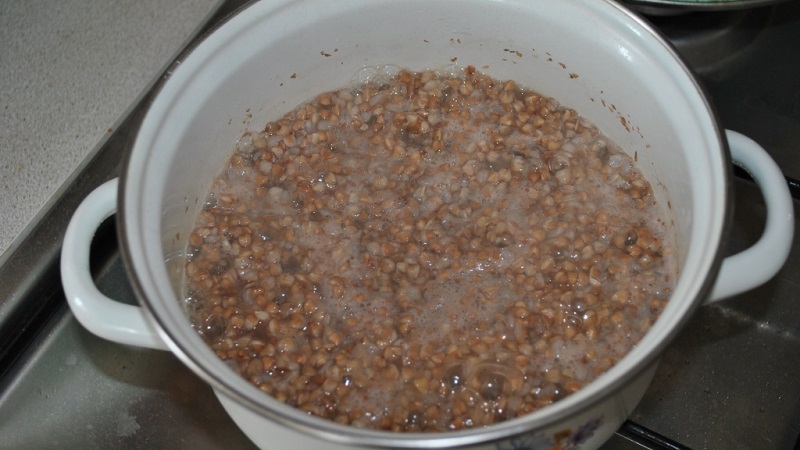
Vitamin P (rutin) in cereals has a positive effect on work of the heart and thyroid gland, increases the elasticity of the walls of the arteries, has anti-inflammatory and bactericidal effects.
In buckwheat no gluten, so it is suitable for people who cannot tolerate this substance. Fiber in cereals helps to effectively cleanse the intestines, normalizes digestion.
You cannot feel normal even without amino acidsthat are present in Greek: methionine, tryptophan, threonine, lysine, arginine.
All vitamins, minerals and other useful elements are in buckwheat in a balanced composition and an easily assimilated form for the body. That is why buckwheat porridge is considered useful for children and adults.
Shelf life of boiled buckwheat
In order for the cooked cereal to bring maximum benefit to the body, it is eaten immediately after cooking.... The cooled, and then warmed-up product, that is, once again heat-treated, stays in the stomach longer and is absorbed more slowly.
This can cause fermentation in the intestines - a person feels bloating, flatulence, sometimes diarrhea or constipation occurs. How much boiled buckwheat is stored in different conditions - we will tell further.
At room temperature
The room temperature ranges from +15 to + 25 ° С. Rooms differ in humidity and air circulation... In the kitchen, the temperature is always higher due to the periodic operation of the gas / electric stove.
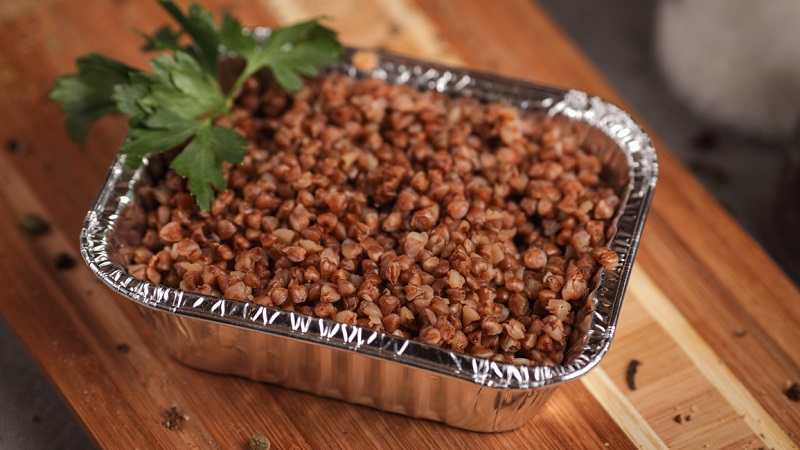
At an average temperature of + 18 ... + 22 ° C, buckwheat porridge cooked in water is left on the kitchen table for no more than 4 hours.
If buckwheat was cooked with the addition of butter, milk, vegetables, meat, mushrooms and other ingredients, it is stored at room temperature for 1.5-2 hours.
Reference. In boiled porridge in the warmth, pathogenic microorganisms quickly multiply - such a product can be poisoned.
In a refrigerator
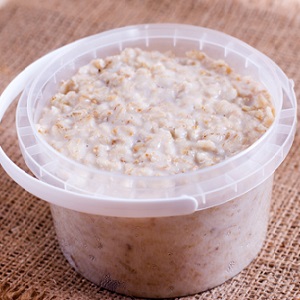 Set the temperature in the refrigerator to + 4 ° С - this is the average temperature, in which products are stored and do not deteriorate during the shelf life.
Set the temperature in the refrigerator to + 4 ° С - this is the average temperature, in which products are stored and do not deteriorate during the shelf life.
For buckwheat boiled in water, this temperature is also suitable... In such conditions, the shelf life of boiled buckwheat will be from three to seven days.
Milk buckwheat (or with the addition of butter) will be fresh for only 24 hours, and with meat, vegetable, mushroom additives - 3 days.
On the balcony
The shelf life of boiled buckwheat on the balcony in the autumn-winter period is as follows:
- up to three days at a temperature of 0 ° С;
- up to seven days at negative temperatures (up to −5 ° С).
A container with porridge is not placed on the balcony if the temperature there is above zero - for example, like in a refrigerator, about + 4 ° C. The humidity on the balcony is higher, because of it, buckwheat becomes covered with white spots - this is the first sign of spoilage.
If frost hits below -5 ° С, buckwheat will freeze... It is thawed in the refrigerator for 24 hours and eaten. But the taste and nutritional qualities of cereals at the same time lose.
Attention! The difficulty of storing buckwheat on the balcony is that there are often sudden changes in temperature. This could damage the product.
How to store boiled buckwheat so that it stays fresh longer
Porridge stays fresher longer if stored in a suitable container... Such a storage container should be tightly closed with a lid.
A glass jar / container with a screw top is ideal... Foreign odors do not penetrate through the glass, and after washing the jar, pathogens do not remain in it.
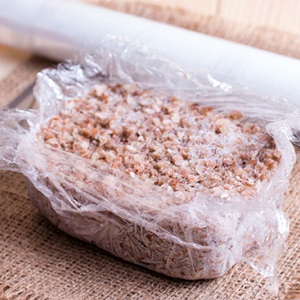 Boiled cereals are also stored in a plastic container... But containers made of this material are often deformed, the lid does not fit tightly and does not provide the necessary protection of buckwheat from extraneous odors. In the process of use, microcracks form on the plastic, pathogenic microorganisms multiply in them. The containers smell unpleasant and washing will not remove odors.
Boiled cereals are also stored in a plastic container... But containers made of this material are often deformed, the lid does not fit tightly and does not provide the necessary protection of buckwheat from extraneous odors. In the process of use, microcracks form on the plastic, pathogenic microorganisms multiply in them. The containers smell unpleasant and washing will not remove odors.
Metal dishes are not suitable for storage... It rusts quickly from washing, the tightness of the closure is not ensured. Metal has a specific odor that is transmitted to the product.
You cannot put a pan in which buckwheat was cooked in the refrigerator... After a day, the product develops an unpleasant bitter taste.
Attention! In two plastic bags, buckwheat is stored only in a freezer at a temperature of -18 ° C. It is not recommended to store buckwheat in bags in the room, refrigerator and on the balcony.
What affects freshness
In order for boiled buckwheat to be as fresh during the shelf life, you need choose right raw kernel in the store.
What they pay attention to:
- Production time: the older the cereal, the less nutrients it retains.
- Buckwheat in bulk deteriorates faster than cereals in prepackaged bags.
- If there are inclusions in the raw core - sticks, grains of other cereals, black unprocessed grains, crushed grains - this indicates the presence of a pathogenic environment, which will lead to rapid spoilage of porridge or dishes prepared from it.
Interesting on the site:
Can there be heartburn from buckwheat and why
Storage rules
Shelf life of raw cereals in unopened packaging - 2 years... Provided that it is in a dark room with a humidity of no more than 70% and an air temperature of no higher than + 25 ° C.
Porridge is not left on the table / balcony in direct sunlightthat heat the container with the product.
Boiled buckwheat absorbs odors in the refrigerator, so it is placed away from foods with a rich smell, and the container is tightly closed.
Before use, impose the amount of porridge that will be eaten... This portion is reheated and the remainder discarded from the plate. It cannot be stored, because pathogenic microbes that cause poisoning multiply in the remnants of heated food, even at negative temperatures.
Both raw and boiled buckwheat are "loved" by insects... During storage, cereals and porridge are inspected for the presence of bugs and flies. If they are found, buckwheat is thrown away - it is already spoiled by the waste products of insects.
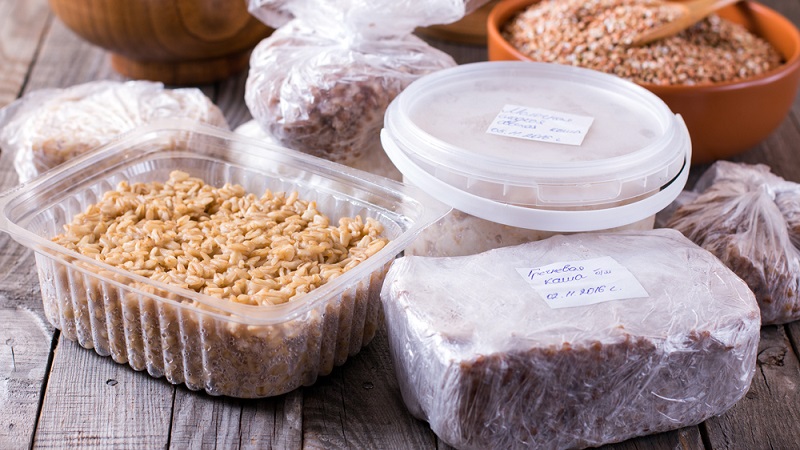
If there is a need to prepare food for future use, buckwheat, boiled in water with salt, frozen in a freezer at a temperature of -18 ° C. Groats are packed in two plastic bags in small portions.Such briquettes are taken with them for fishing, hiking or hunting. They are heated over a fire and add meat / vegetable / fish ingredients to them.
Important! Frozen buckwheat is stored for 4 weeks. If it is left for a longer period, condensation forms in the bags, due to which the buckwheat deteriorates.
How to understand that buckwheat has already deteriorated and cannot be eaten
How to understand that you can't eat buckwheat so as not to get poisoned:
- sour / unpleasant or musty / rancid odor;
- mucus at the bottom of the container with porridge;
- mold - the groats become whitish;
- bitter taste;
- the presence of insects.
Conclusion
Boiled buckwheat is stored on the kitchen table, in the refrigerator, on the balcony, in the freezer - in different places the shelf life will differ. It also depends on the container used, the production date and shelf life of the kernel, proximity to other products. If all the conditions are met, a delicious and, most importantly, healthy product will appear on the table.